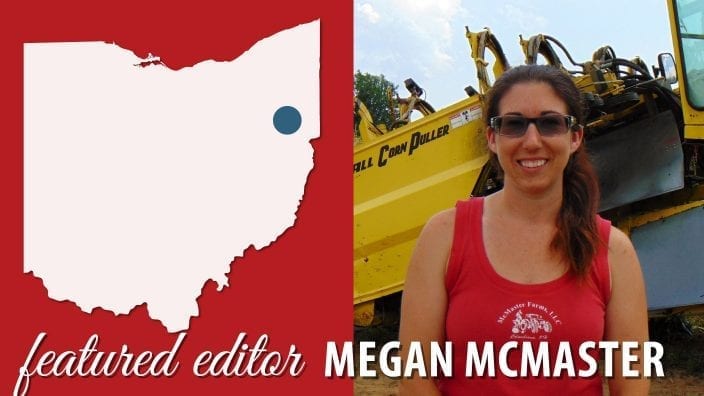Farmer’s Guide to Trucking Regulations available to Ohio Farm Bureau members
The guide includes a farm driver checklist, overview of state and federal regulations and exemptions, CDL qualifications and more.
Read More
Megan McMaster from Columbiana County is the editor of the July 29, 2019 Growing our Generation enewsletter, featuring insights and ideas directly from Ohio’s young farmers and food and agricultural professionals.
 My name is Megan McMaster and I live in Columbiana, Ohio in Columbiana County. I reside with my husband, Philip and our two children, Caitlin and Abigail, on his family’s farm: McMaster Farms. My husband is fourth generation on the farm where we grow bi-color sweet corn, pumpkins and grain crops including field corn, soybeans, wheat and barley. On the farm, we have a retail stand where we sell our corn as well as other local produce, but we are mostly a wholesale operation. We sell to farm markets, roadside stands and small local grocery stores as well as some chain grocery stores.
My name is Megan McMaster and I live in Columbiana, Ohio in Columbiana County. I reside with my husband, Philip and our two children, Caitlin and Abigail, on his family’s farm: McMaster Farms. My husband is fourth generation on the farm where we grow bi-color sweet corn, pumpkins and grain crops including field corn, soybeans, wheat and barley. On the farm, we have a retail stand where we sell our corn as well as other local produce, but we are mostly a wholesale operation. We sell to farm markets, roadside stands and small local grocery stores as well as some chain grocery stores.
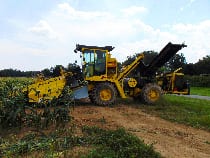 Our sweet corn is harvested by machine and is then brought into the farm where we hand grade and sort the ears out. The good ears go onto a conveyor that is one of a kind. It has slots for each ear of corn, and they then travel down to the end of the line where a machine with plungers counts each ear that goes into our mesh bags. We pack our bags of corn in five dozen. For larger orders that go into our semi-trailers for distribution, we pack the sweet corn into wooden crates. Our grading line is changed over so that the corn counting machine is not used, but a large rotating table is put underneath to allow the corn to flow from the grading line to the table to be hand counted and put into the crates. The crates are then stacked onto pallets and ran through our hydrocooler. The hydrocooler brings the temperature of the corn down so that it locks in the freshness before going into our cooler building. Our farm has shipped as far south as Florida and as far north as Canada.
Our sweet corn is harvested by machine and is then brought into the farm where we hand grade and sort the ears out. The good ears go onto a conveyor that is one of a kind. It has slots for each ear of corn, and they then travel down to the end of the line where a machine with plungers counts each ear that goes into our mesh bags. We pack our bags of corn in five dozen. For larger orders that go into our semi-trailers for distribution, we pack the sweet corn into wooden crates. Our grading line is changed over so that the corn counting machine is not used, but a large rotating table is put underneath to allow the corn to flow from the grading line to the table to be hand counted and put into the crates. The crates are then stacked onto pallets and ran through our hydrocooler. The hydrocooler brings the temperature of the corn down so that it locks in the freshness before going into our cooler building. Our farm has shipped as far south as Florida and as far north as Canada.
In the fall, we pick pumpkins for farm markets as well as roadside stands and grocery stores. Our pumpkins range from small to large and a variety of different colored specialty pumpkins as well. During the pumpkin season, we also have cornstalks, gourds and Indian corn. On the farm we hand pick and pack our pumpkins out in the field into tall gaylord (cardboard) bins. They then are brought back into the farm and unloaded from the wagon by forklift. We ship them via our gooseneck trailer, semi-trailer and small box truck. Stores and local farm markets pick up orders on the farm as well.
Finding workers
If you ask any farmer how they are, the first thing they will say is either, “Not bad, just can’t find any help” or “This weather is just something, isn’t it?” We are all starting to struggle in one way or another with finding the employees that we need to get the job done around the farm and get it done right. Within the past five or so years the change in the amount of applications we have gotten has declined. Without the proper amount of help we need, more hours are worked to pack our sweet corn as well as some produce must be left in the field if we can’t get it picked and packed when it needs to be harvested. Fewer young people are applying on our farm. Each year we have fewer skilled workers apply as well, which means less people to run forklift or tractor.
Being able to get crops planted with less people means longer days for the employees that we have. When you look to the future of farming, we all wonder where we are headed. Will we have enough people to work and continue? Some farms have less employees now because they have changed the crops that they grow. They look at the big picture and see what crops they could grow and harvest with less people. With our operation, we have noticed an increase in the amount of people who are applying that already have full-time jobs. They want that extra bit of money during our harvest season and we work around the schedule that they have at their other job. We have had to adapt to the changes we have seen.
Farming is very labor intensive, hard work and long hours plus being seasonal puts a lot of people off. It’s also not a 9 a.m. to 5 p.m. kind of work either. A lot of people are disconnected from agriculture so they don’t know what applying to work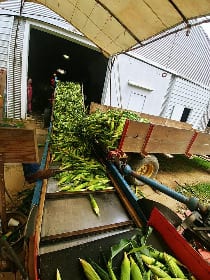 at a farm entails. You talk to any farmer and he or she can tell you story after story of the amount of people that have started working and who haven’t lasted the day. It makes it even more difficult when you harvest and work for only part of the year when we and other farms need the extra help.
at a farm entails. You talk to any farmer and he or she can tell you story after story of the amount of people that have started working and who haven’t lasted the day. It makes it even more difficult when you harvest and work for only part of the year when we and other farms need the extra help.
Vegetable Growers News did a survey of farms and asked if they had enough workers for the 2018 season. 54% said that they did not. This number has slowly increased over the years. Many of the participants have had to make changes to their operations to continue to run including limiting what they harvest and even cutting out certain produce that takes more manpower and hours to harvest.
Changes to the H-2A program may help, but is it enough? Programs like the H-2A have helped many farmers. Some who I have spoken with in our area have mentioned how it has saved them from cutting back acreage or even closing. In addition to shifts in programs and regulations, we must contend with changes to wage increases and expectations of what employees feel they should be paid. Will we survive these challenges? Absolutely. We, as farmers, have had to change every step of the way in our operations and we will continue to find ways to improve and to overcome.
Food safety
One of the biggest concerns to any farm is food safety. Recalls are always in the news now and farmers must be even more vigilant in how they harvest and handle their product more than ever. On our farm we participate in a third party food safety audit. This audit is performed by Ohio Produce Growers & Marketers Association, which established the Ohio Produce Marketing Agreement, a GAP certification made for Ohio farmers by Ohio farmers. We really like this organization because they understand farmers and the dilemmas that they face. Our larger customers require that we have a certificate for our food safety, and we started our food safety program many years prior to needing to have any documentation. Starting in our field, we have practices that we implement for safe harvesting of our produce as well as the delivery and grading of our sweet corn. Documentation is key with food safety, if you didn’t write it down it didn’t happen. Our food safety coordinator and I oversee the filing of that documentation every day. We have a great program from Orizant called Sapphire that we use to record all our tests and checks that we do of our tools, equipment, water and employees.
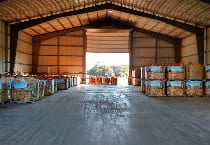 We also have good agriculture practices that we teach to our employees upon hiring. They are trained to know how to safely handle the produce. In addition to our training and documentation we, also, have a label trace back program that we use from T3 Technologies called ProduceScan. This program allows us to enter in our field information and print labels to go onto our wooden crates. The labels have our farm information as well as what the product is and a barcode that corresponds to the field location.
We also have good agriculture practices that we teach to our employees upon hiring. They are trained to know how to safely handle the produce. In addition to our training and documentation we, also, have a label trace back program that we use from T3 Technologies called ProduceScan. This program allows us to enter in our field information and print labels to go onto our wooden crates. The labels have our farm information as well as what the product is and a barcode that corresponds to the field location.
We have felt that food safety is the No. 1 most important thing we can do and train our employees for. Safe handling practices are a must. We as farmers may not be able to control how our product is handled outside of our care but we can control how we as producers handle it. Dealing with grocery chains and smaller stores that require food safety, we must stay up-to-date on the regulations and take classes multiple times a year. Our farm usually participates in OPGMA Congress that is now held in Columbus, Ohio. They have great classes and programs to take that cover a wide range of food safety programs as well as fruit and vegetable classes. Staying updated on new diseases that affect your crop, new handling practices, regulations and documentation guidelines helps in continuing a well-rounded food safety program on your farm. They also have a great group of people that can answer all your questions on getting started with a program on your farm. Food safety can be intimidating at first, but any steps to improve how we handle our produce safely is a step in the right direction. Visit the OPGMA website to take that first step in food safety.
SUBSCRIBE to receive Growing our Generation, a biweekly eletter with a different featured editor to meet each issue. Browse the archive of past issues.
This e-newsletter is brought to you by Ohio Farm Bureau’s Young Ag Professionals. Learn more about Farm Bureau membership, including a discounted category for those 18-24 years old.


The guide includes a farm driver checklist, overview of state and federal regulations and exemptions, CDL qualifications and more.
Read More


Ohio Farm Bureau provides opportunities, platforms and resources to help you develop your voice in the industry and give farmers a seat at the table with leaders and legislators.
Read More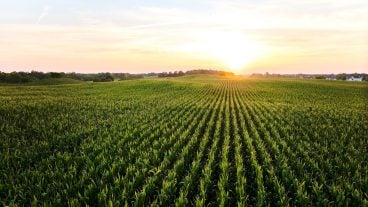
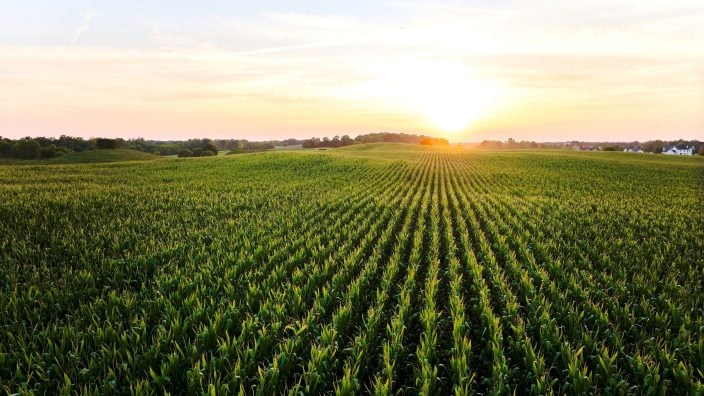
The emergency fuel waiver to allow the sale of summer gasoline blends containing 15% ethanol will lengthen the period during which Americans can continue buying E15 from June 1 to Sept. 15.
Read More

The Small-Scale Food Business Guide covers federal and state regulations for selling food products such as raw meat, dairy, eggs, baked goods, cottage foods, fruits and vegetables, honey and more.
Read More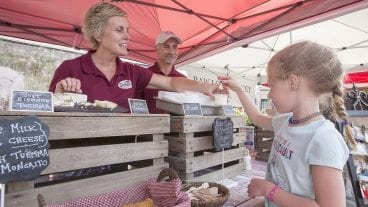
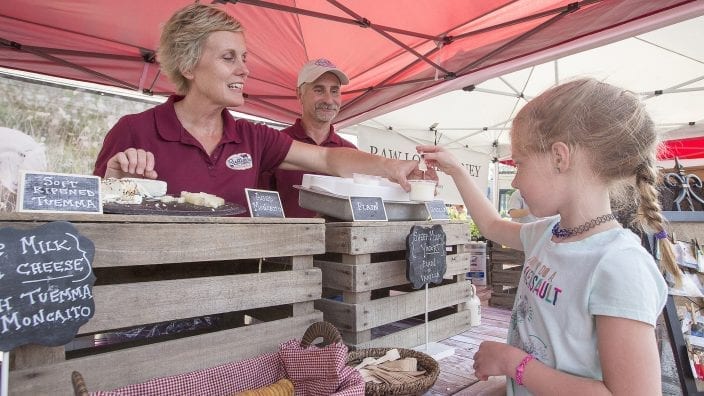
New resources and technology are broadening the different types of sales tools and strategies available to farmers.
Read More

ODA will enroll 500,000 acres into the program for a two-week sign-up period, beginning April 22, 2024, through May 6, 2024. Contact local SWCD offices to apply.
Read More

Katie Share of Columbus has been named ExploreAg and Youth Development Specialist for Ohio Farm Bureau.
Read More

Mary Klopfenstein of Delphos has been named Young Ag Professional and Ag Literacy Program Specialist for Ohio Farm Bureau.
Read More

The plan has been updated to give sole proprietors access to more rate stability and a smart solution that offers potential savings on health care.
Read More

The American Farm Bureau Federation, in partnership with Farm Credit, is seeking entrepreneurs to apply online by June 15 for the 2025 Farm Bureau Ag Innovation Challenge.
Read More